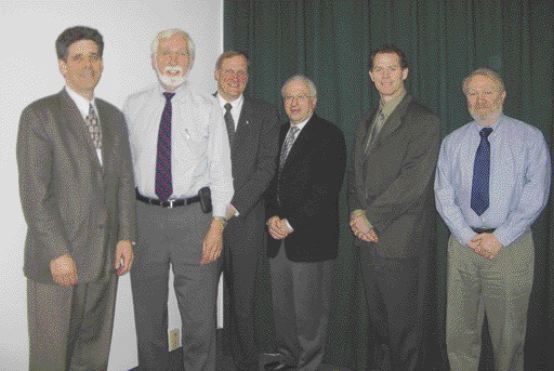
Features
Research & Innovation
Paprican Day is all about networks and partnerships
Once again this year, Paprican took advantage of the Paperweek/Exfor 2005 platform and invited students and researchers to their Pointe-Claire headquarters for a networking day. The event was a huge s...
May 1, 2005 By Pulp & Paper Canada

Left to right: Andr Isabelle (director
Once again this year, Paprican took advantage of the Paperweek/Exfor 2005 platform and invited students and researchers to their Pointe-Claire headquarters for a networking day. The event was a huge success, attendees filled up the Paprican conference room to capacity. The main subject: R&D networking.
Right now, networking is the word in the R&D field for a very simple reason: the pulp and paper industry has changed. Advantages like inexpensive power, accessible labour force, easy access to markets and fibre source, have disappeared. The Canadian competitive advantage has eroded, there is increased competition on a global scale and consolidation is still taking place. For Dan Wicklum, executive director at the Canadian Forest Innovation Council, innovation holds solutions to address our new reality: innovation in sustainability, environmental quality, extracting value from the full production chain and coming up with new products and processes.
“Right now, individual institutions are effective but major opinion leader support is inconsistent,” Wicklum explained. “The parts do not add up into a coherent whole, there is no clear sense of a collective purpose and no mechanism to get there.” That is until the Canadian Forest Innovation Council (CFIC), a partnership between three major innovation funding constituencies: the Government of Canada, provinces and territories and the industry. The focus is to develop consensus on a national R&D vision, to develop and advocate the means to deliver that vision and to champion innovation to key decision makers with the objective to increase innovative investments.
“The CFIC workplan is divided in three parts: first, set and prioritize high level goals; then, check alignment of existing activities against the goals; and third, change activities to increase alignment with the goals. At the moment, CFIC is in the third stage of its mapping exercise,” Wicklum added.
Dr. David Layzell, CEO and research director, BioCap, discussed a few strategies for building true national research networks since it is the best tool to coordinate, create, train and profile R&D projects. In that sense, Biocap represents “a network of networks”, regrouping 11 different R&D networks. But how do you go about it? Layzell said you can create a traditional network or a De Novo network model. The traditional one is ideal for large integrated research effort, with a 5-14 years funding window. It’s also an excellent training environment. On the under hand, it is not very flexible, it is not easily scalable and can become exclusive, to the point that it will be difficult to address efficiently certain key issues. “The De Novo network model works well in terms of time and energy. It leaves more room for innovation and intellectual property. It also allows to separate network advocacy/coordination from peer review initiatives. For companies in a competitive research environment, De Novo networks may be the best option,” Layzell concluded.
Dr. George Rosenberg, managing director of PAPIER, was also on hand to briefly represent the PAPIER organization, which offers a single point of access for the pulp and paper industry “to mobilize the innovation capacity of Canadian universities.”
“Our biggest challenge right now is to juggle with insufficient funding to support research networks. We are talking about $11 million over a period of five years for 24 researchers. And the funding does not come easy: success rate is low and it’s an expensive process to do it well,” Dr. Rosenberg added. That’s why PAPIER is working on new research models and approaches, that are smaller in scope ($500,000 over three years) and closer to mainstream pulp and paper applications.
Finally, Andr Isabelle, director, Environment and Natural Resources Research Partnerships Program, NSERC (National Sciences and Engineering Research Council of Canada) addressed a very interested crowd about the structure of NSERC.
The Council works in three program areas, namely People (about 7,000 students throughout the country), Discovery (funding the work of about 10,000 professors) and Innovation (partnership programs). Isabelle was happy to announce that there is actually tremendous growth in first time applicants for NSERC grant programs. “In 2003-2004, the NSERC budget was $131 million. About 65% of Canadian university researchers working in the natural sciences and engineering are NSERC-funded. With an annual investment in excess of half a billion dollars, NSERC’s role within the research community is both primary and crucial. We know who is doing what, where, with whom and for whom. We can rapidly put you in touch with the researchers, the work, the universities and the industrial partners you are looking for. No fees — no charges!”
There are many types of grants which can be of interest for researchers in the pulp and paper field: collaborative research grants (CRD), industrial research chairs (IRC), strategic program grants, research partnership agreements (RPA), research networks (RN) and Idea to Innovation program.
Print this page